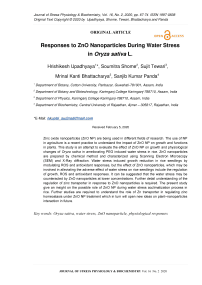Responses to ZnO nanoparticles during water stress in Oryza sativa L
Автор: Upadhyaya Hrishikesh, Shome Soumitra, Tewari Sujit, Bhattacharya Mrinal Kanti, Panda Sanjib Kumar
Журнал: Журнал стресс-физиологии и биохимии @jspb
Статья в выпуске: 2 т.16, 2020 года.
Бесплатный доступ
Zinc oxide nanoparticles (ZnO NP) are being used in different fields of research. The use of NP in agriculture is a recent practice to understand the impact of ZnO NP on growth and functions in plants. This study is an attempt to evaluate the effect of ZnO NP on growth and physiological changes of Oryza sativa in ameliorating PEG induced water stress in rice. ZnO nanoparticles are prepared by chemical method and characterized using Scanning Electron Microscopy (SEM) and X-Ray diffraction. Water stress induced growth reduction in rice seedlings by modulating ROS and antioxidant responses, but the effect of ZnO nanoparticles, which may be involved in alleviating the adverse effect of water stress on rice seedlings include the regulation of growth, ROS and antioxidant responses. It can be suggested that the water stress may be counteracted by ZnO nanoparticles at lower concentrations. Further detail understanding of the regulation of zinc transporter in response to ZnO nanoparticles is required. The present study give an insight on the possible role of ZnO NP during water stress acclimatization process in rice. Further studies are required to understand the role of Zn transporter in regulating zinc homeostasis under ZnO NP treatment which in turn will open new ideas on plant-nanoparticles interaction in future.
Oryza sativa, water stress, zno nanoparticle, physiological responses
Короткий адрес: https://sciup.org/143171168
IDR: 143171168
Текст научной статьи Responses to ZnO nanoparticles during water stress in Oryza sativa L
Nanotechnology has wide applications in different field of science. The use of nanoparticles to modulate growth of plants and to control against plants pathogen is a recent practice (Zhang et al., 2005, Galbraith et al., 2007, Mahajan et al., 2011, Boonyanitipong et al., 2011). Various studies had revealed a numbers of good attempt to understand the impact of nanoparticles (ZnO) on the growth of plants and bacteria (Mahajan et al., 2011, Boonyanitipong et al., 2011, Upadhyaya et al ., 2018). Liu and Lal (2015) suggested positive impact of ZnO NP on plant with its potential to be use as future nano-fertilizer (Liu and Lal, 2015). The present study evaluates the interactive effect of ZnO nanoparticles on growth and biochemical changes during water stress conditions.
Zinc is a micronutrient involved in various physiological functions of plants , the inadequate supply of which reduces crop yields (Chanu & Upadhyaya, 2019). It is a part of many enzymes such as superoxide dismutase, catalase etc., which prevents oxidative stress in plant cells. Zinc is known to play certain roles in production of auxin, an essential growth hormone. It also regulates starch formation and proper root development besides its role in synthesis of chlorophyll and carbohydrates. Zinc helps in the biosynthesis of cytochrome; a pigment. It maintains membrane integrity, and synthesis of leaf cuticle. Zinc plays a fundamental role in protecting and maintaining structural stability of cell membranes (Cakmak, 2008, Cakmak, 2000). Zn is an important micronutrient for protein synthesis, membrane function, cell elongation and abiotic stress tolerance (Cakmak, 2000). Recent reports suggest that Zn plays important role in ameliorating abiotic stress (Upadhyaya et al., 2013) and protects plant from ROS damage (Cakmak, 2008, Cakmak, 2000). However, there is no report on impact of nanosized Zn during abiotic stress acclimation. In the present study, we examined the effects of nano-ZnO, on one of the most important food crop (Rice, Oryza sativa L.) during water stress.
MATERIALS AND METHODS
Plant material and growth conditions
Rice ( Oryza sativa L.) seeds were procured from Regional Agricultural Research Station, Akbarpur,
Karimganj , Assam. Required amount of viable rice seeds (cv, Konakalata) was taken and surface sterilized with 0.1% HgCl 2 solution for 3-5 minutes with successive shaking. Seeds were then thoroughly rinsed with distilled water and decanted. Then the seeds were transferred in Petri plates containing moisten filter paper and germinated at 28oC for 4 days. On the 5th day of incubation germinated seeds were grown in plastic cups. The healthy germinated and uniform seeds were transferred in the plastic cups (150 ml) containing half strength Hoagland nutrient medium and were grown in growth chamber under 16h/8h light/dark cycle in the growth chamber at 22±30C for 6 days. The nutrient solution was changed after every two days for healthy growth. On the 6th day plants were treated with 0% PEG (Control), 5% PEG and 10% PEG-6000, 50μM ZnO NP and 5% PEG + ZnO NP and 10% PEG + ZnO for 48h. Each cup contained at least ten plants for each cultivars. Plants were sampled after 48h of treatment and data presented are means of three independent repeats.
Synthesis and characterization of ZnO NP
For synthesis and characterization of ZnO NP , the aqueous solution of zinc sulfate (ZnSO 4 ), sodium hydroxide (NaOH) solution was added slowly drop wise in a molar ratio of 1:2 under vigorous stirring. The stirring was continued for 12 hrs. The precipitate thus obtained was washed thoroughly with distilled water until the impurities were removed from the precipitate. The resulting precipitate was dried in an oven at 100 0C for 12 hours and calcined at 500°C for 2 hrs. The powdered samples were then characterized by XRD, SEM and EDX. Structural analysis of the sample was made by X-ray Diffraction studies with Cu K α radiation (k = 1.5418 A °) as X-ray source at 40 kV and 30 mA in the scanning angle (2θ) from 20 to 70o. The resulted XRD pattern was analysed using X’Pert High Score software by search match tool, it was found to match with the ICDD Reference Pattern of Zinc Oxide, 01-070-8072. The samples were also studied by SEM-EDX with JEOL JSM- 6480 LV to verify the particle size and composition.
Root, shoot length and dry mass analysis
Incase of root, shoot length and dry mass the plants were sampled after 48hs of treatment taking rice seedlings at least 10 plants per treatment. Root and shoot length were measured using centimeter ruler and to estimate the dry mass and expressed in g plant-1 root and shoot tissues were oven dried at 80 0C for 48h. Root to shoot ratio was measured by dividing root length by shoot length. Total dry mass of plant was estimated by adding root and shoot dry mass.
RWC measurement
Relative water content (RWC) is an important index to measure physiological water content in plants which was measured by standard method (Bars et al., 1962). Fresh mass of root and shoot were measured and allowed to immerse in distilled water for 24h at room temperature and turgid weight was measured. Tissues were then dried at 800 C for 24 h to measure the dry mass.
Enzyme analysis
For enzyme analysis, the tissues were homogenized with 50mM Tris HCl (pH 6.8) in a pre-chilled mortar and pestle. The extract was centrifuged at 4° C for 10 min at 10,000 rpm in a cooling centrifuge The resulting supernatant was considered as enzyme extract and was used to estimate the activity of peroxidase (POX), catalase (CAT) and super-oxide dismutase (SOD). The activity of CAT was measured by the method of Aebi (1984) by measuring absorbance change at 240 nm due to disappearance of H 2 O 2 and by using the extinction coefficient 0.036 mM-1 cm-1 expressed as mole H 2 O 2 destroyed min-1g fresh weight (FW) (Aebi, 1984). POX activities was estimated by following Chance and Maehly (1955) (Chance and Maehly, 1955). For the activity of SOD the method of Giannopolitis and Reis (1997) was followed. For the assay mixture 79.2 mM Tris HCI buffer (pH 8.9), having 0.12 mM EDTA and 10.8 mM tetra ethylene diamine, bovine serum albumin (3.3 x 10-3 %), 6.0 mM NBT, 600 µM riboflavin in 5.0 mM KOH and 0.2 ml of tissue extract was taken (Giannopolitis and Reis, 1997). The test tubes containing this reaction mixture was incubated in between two tube lights (Philips 20 W) for 10 min which was followed by absorbance reading at 560 nm.
Reactive oxygen species analysis
In case of ROS analysis it was measured in terms of superoxide anion (O2-) and hydrogen peroxide (H2O2) content in root and shoot of treated growing seedlings of rice by following the method of Doke and Lin and Kao respectively (Doke, 1983, Lin and Kao, 2001). Superoxide anion (O2-) was assayed spectrophotomet-rically by measuring the reduction of nitrobluetetrazolium (NBT). Ten leaf disks (diameter = 3 mm) were immersed in a solution (2 ml) containing 0.05% NBT, 0.01 M sodium phosphate buffer (pH 7.8), and 10 mM NaN3 in a beaker. After incubating the mixture for 60 minutes at room temperature, 1.5 ml of the reaction solution was transferred into a micro-centrifuged tube and was heated at 85 °C for 15 minutes. Then the solution was cooled, and its absorbance was read at 580 nm. For determining O2- generation, NBT reducing activity was expressed as the increase in A580 per hour per gram of fresh weight.
For determining H 2 O 2 , 100 mg plant tissue were homogenized in 2 ml of 0.05M phosphate buffer at pH 7.4 and the homogenate was centrifuged at 15000 g for 25 minutes. Then 1.5 ml of supernatant was added with 0.5 ml of 0.1% TiCl 2 and the mixture was again centrifuged at 15000 g for 15 minutes and then the absorbance was read at 410 nm
Zinc content
For zinc content estimation the tissue from treated and control plants subjected to stress and recovery conditions were briefly rinsed with deionized water and oven dried at 80oC for 48h. In the 5 ml of acid mixture 3:1 (HNO 3 : HCl), 100mg of dried sample was digested. The atomic absorption spectrophotometer was used to estimate Zn content in sample volume that was adjusted to 20 ml with deionised water.
Data analysis
Each experiment was repeated thrice and data presented are with mean standard error (SE ). The data analysis were carried out using MS Excel. LSD test was done to compare significant mean difference from control.
RESULTS AND DISCUSSION
ZnO synthesis and characterization
ZnO nanoparticles were synthesized by chemical method and the prepared samples were characterized by XRD, SEM and EDX. As shown in Fig 1A., EDX result reveals that the sample contains ZnO only with no impurities. Figure 1B, depict typical XRD pattern of ZnO samples having polycrystalline nature with peaks along the planes (002), (101), (102), (103), (112) and (104). The peak which have highest intensity is found along the plane (101). The observed XRD pattern was analysed, fitted and refined using X’Pert HighScore software by search match tool, it was found to match with the ICDD Reference Pattern of Zinc Oxide, 01-070-8072. The particle size D was calculated using the Debye-Scherrer formula (Ghosh et al.,2013).
■D 0.89л (1) jScos# where, λ is wavelength of the incident X-ray (λ = 1.5418 Å), β is the corrected FWHM for instrumental broadening and θ is the angle at which the highest intensity peak occurs. The average particle size, thus calculated was found to be in the range from 88.6 nm.
The samples were also studied by SEM-EDX with JEOL JSM- 6480 LV to verify the particle size and composition. As observed from the micrographs (Fig 1C), formation of ZnO nano-flowers is clearly visible. The particle sizes observed from the SEM micrographs correspond to the values estimated from the XRD data. The formation and stability of ZnO NPs in the solution were monitored by using an absorption peak at 374 nm in UV visible spectrophotometer. Such peak suggests the formation of ZnO NPs which is in good agreement with earlier report (Ghosh et al., 2013) one highest peak for ZnO with average particle size of 80-100 nm was observed.
Morphological responses
Several studies have shown that water stress affects plant metabolism and its nutrient uptake by roots and other physiological processes (Upadhyaya et al., 2011). Our study with rice seedlings reveals water stress results inhibition of root and shoot growth in rice. Few morphological changes was observed in response to water stress by the growth analysis of rice seedlings when subjected to 5 and 10% PEG for 48h. Although, comparative analysis of growth inhibition by water stress in rice plants showed varied response, morphologically less visible toxicity symptoms were evident.
Changes in RWC and growth responses of rice during water stress and ZnO interaction
The effect of water stress in the growth of growing seedlings of rice was significant. An exposure to 5 and 10 % PEG caused significant changes in root and shoot length of rice (Fig. 2). There was a significant decrease in root length in plant treated with 10% PEG. In contrast the changes in shoot length were comparatively lesser in ZnO treated plant and its interaction with 5 and 10% PEG treatment. Water stress induced reduction in shoot elongation was evident in PEG treated plants when compared with control and ZnO treated plant during stress (Fig. 2). This was also evident from declining shoot dry biomass upon water stress treatment (Fig. 2). Further as compared to control root dry mass showed inconsistent results. The changes in shoot dry mass due to water stress treatment also varies among ZnO and its interaction treatment. The shoot dry mass decreased due to water stress but it increased under ZnO NP and water stress in presence of ZnO NP treatment (Fig. 2). The changes in total biomass of rice due to water treatment also varied among during water stress, ZnO NP and their interaction studies (Fig 2). ZnO nanoparticles treated cultivars showed little increase in total dry mass during stress relative to control and stress plants. Thus ZnO NP showed some growth promotive role during short term water stress. However detailed studies are need to study the role of ZnO NP in acclimatizing moderate and long term water stress.
Water stress tolerance thresholds vary greatly between species of plants and affect tissues depending on metabolic requirements. During water stress nutrient concentrations in the medium tend to decrease due to decrease root growth before shoot growth. The growth reduction in rice due to water stress is due to ROS generation in plants (Upadhyaya et al., 2011) RWC of plant changes during waters stress. As shown in Fig. 2, RWC declines with progressive water stress showing the loss of plant water content. In the present study RWC decreased to 78 and 94 % in water stressed root relative to 88.37 and 97.8% in control root and shoot respectively. However, ZnO NP did not show significant difference from control.
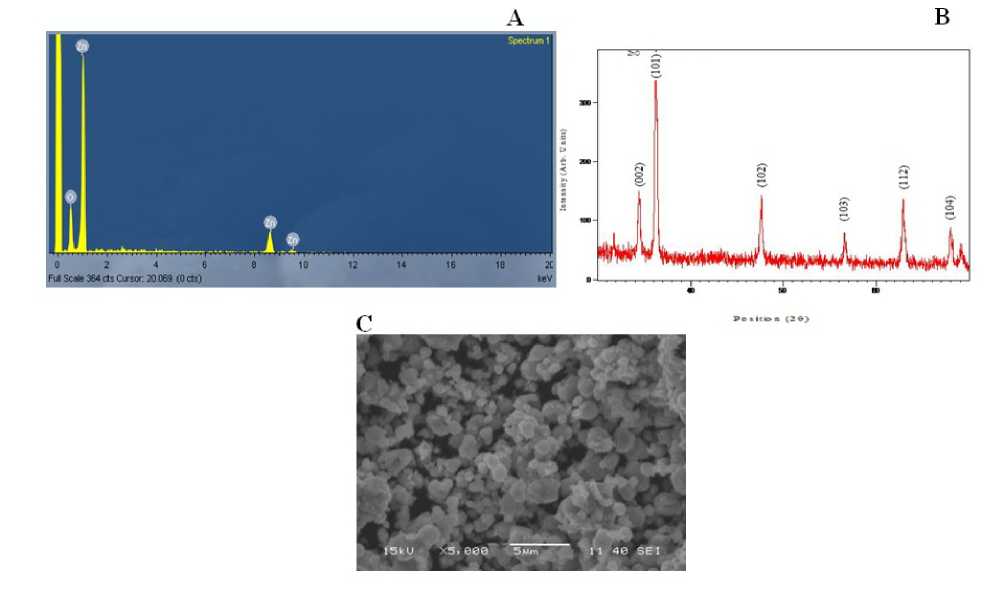
Figure 1: Energy dispersive spectra of ZnO nano particles calcined at 500 0 C(A), XRD pattern (B) and Scanning electron micrograph of chemically synthesized ZnO nano particles (C ).
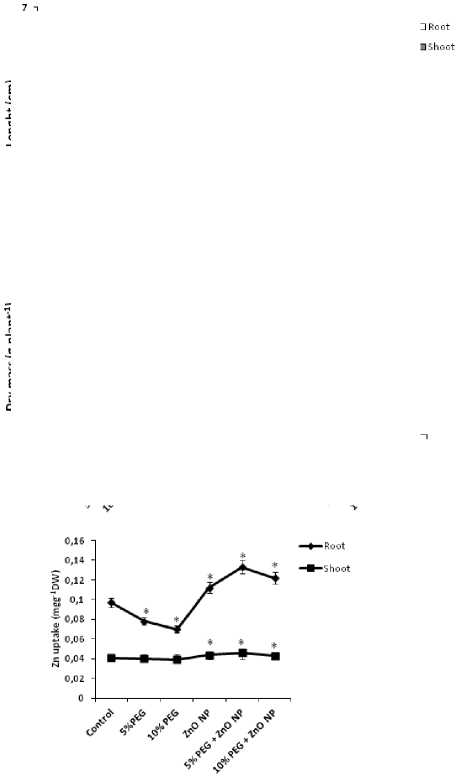
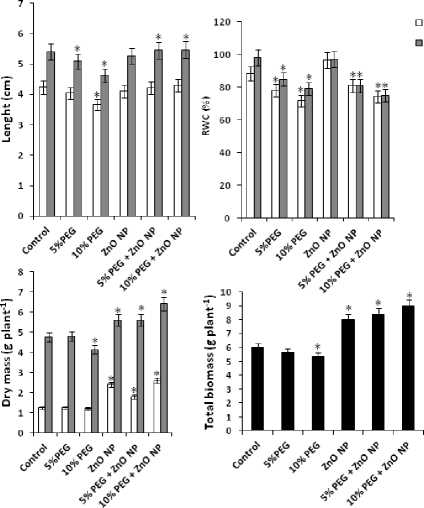
Figure 2: Changes in length , RWC, dry mass, Zn uptake in root and shoot and total biomass of growing seedlings of rice [ Oryza sativa (L)] subjected to PEG induced water stress and ZnO NP (6 mg/L) interaction on. Data presented are mean ±SE (n=3). * indicates significant difference from control at P<0.05 by LSD test.
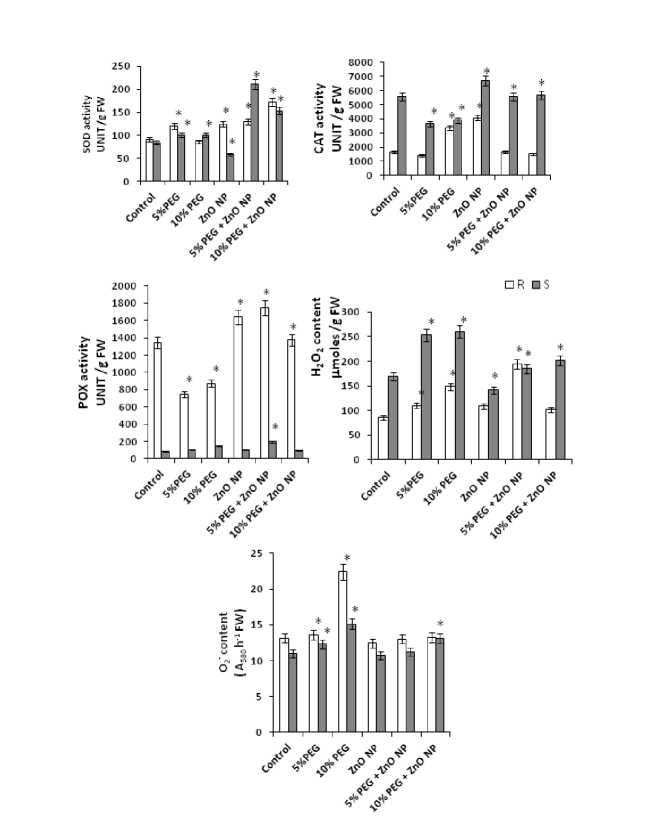
Figure 3: Changes in superoxide dismutase (SOD), catalase (CAT) peroxidase (POX) activities, hydrogen peroxide (H 2 O 2 ) and superoxide anion (O 2- ) content in root and shoot of growing seedlings of rice [ Oryza sativa (L)] subjected to PEG induced water stress and ZnO NP (6mg/L) interaction. Data presented are mean ±SE (n=3). * indicates significant difference from control at P<0.05 by LSD test.
ROS and antioxidant responses
One of the most damaging impact of water stress is the accumulation of ROS in plants which potentially oxidize biomolecules (Upadhyaya et al. 2017) Plant has evolved antioxidant defence system to cope with stress induced ROS generation. Zinc is an essential nutrient that affects numerous physiological processes in plants via functions such as , cofactor of various enzymes and as the key structural component of regulatory proteins. The uptake and transport of Zn efficiently regulated in plants to achieve intracellular Zn homeostasis through specific transporters which functionally control Zn influx, efflux, and compartmentalization in plant cell. Zinc nutrition is known to affect plant water relations by altering stomatal conductance and transpiration rates which consequently declined due to zinc deficiency (Hu et al., 1991, Sharma et al., 1994, Khan et al., 2004). Zinc may protect plant cells from damage by reactive oxygen species as it potentially affects plant cell metabolism (Cakmak, 2008, Cakmak, 2000, Broadley et al., 2006). However, little information about the effect of zinc nutrition on drought stress induced biochemical damages in plant is available (Upadhyaya et al., 2013). In the present study Zn content decreased during water stress. As depicted in Fig. 2, the Zn content of both root and shoot of rice plant subjected to ZnO NP and its interaction with water stress increased. In the present study, ZnO NP at selected concentration mediate antioxidant responses as shown in Fig. 3. The activity of SOD was enhanced by ZnO NP in both control and stress conditions in both root and shoots of growing rice seedlings. The activity of CAT increased mainly in shoot due to ZnO NP in both control and stressed plants but water stress resulted decreased in CAT activities. Such enhanced CAT activities mediated by ZnO NP may improve water stress acclimatizing potential of rice. Similarly POX activities while decreased in stressed plant ZnO NP during stressed and control conditions increased POX activities mainly in roots (Fig. 3). Changes in ROS content was studied in terms of O2- and H2O2 content as depicted in Fig. 3. Water stress induced accumulation of both the ROS in rice plant. However, ZnO NP lowered ROS accumulation in both control and stressed conditions. This may be attributed to ZnO NP mediated altered antioxidant function in rice. The role of Zn in protecting plant cells from damage by reactive oxygen species may be an important response in water stress tolerance and not simply affecting plant water relation, dry matter accumulation and changes in antioxidant balance under water stress. The present study suggests that PEG induced water stress is minimized by ZnO nanoparticles during both stress and control conditions. It would be interesting to study in future detail molecular physiology of Zn transporter and their interaction in rice during water stress in presence of ZnO NP and its revival mechanism in rice
CONCLUSION
In conclusion it may be suggested that the water stress induced growth reduction in rice seedlings, but the effect of ZnO nanoparticles, which can be involved in alleviating the adverse effect of water stress on rice seedlings include the stimulation of growth parameters and the antioxidant responses. It can also be suggested the water stress induced damages may be counteracted by ZnO nanoparticles at lower concentration. Further, detail study on the ZnO nanoparticles effect on physiological events during water stress and physiochemical and antioxidative responses of growing seedlings of rice ( Oryza sativa L ) can reveal the exact mechanism underlying the amelioration of water stress by ZnO nanoparticles plants in rice seedlings in particular. The present study is an attempt to understand the physiological effect of ZnO nanoparticles on plant during mild water stress. Further detail understanding of the regulation of zinc transporter in response to ZnO NP nanoparticles is required to study the possible role of zinc transporter protein and their interaction during water stress acclimatization in rice which in turn will open new ideas on biointerface on protein–nanoparticles interaction in future.
ACKNOWLEDGEMENT
Список литературы Responses to ZnO nanoparticles during water stress in Oryza sativa L
- Aebi H. (1984) Catalase in vitro. Methods Enzymol, 105, 121-126
- Bars H.D., Weatherly P.E. (1962) A re-examination of the relative turgidity technique for estimating water deficit in leaves. Aust. J. Biol. Sci., 15, 413-428
- Boonyanitipong P., Kositsup, B., Kumar, P., Baruah, S., Dutta, J. (2011) Toxicity of ZnO and TiO2 Nanoparticles on Germinating Rice Seed Oryza sativa L. Int J Biosci, Biochem Bioinfor., 1, 282-285
- Broadley M.R., White P.J., Hammond J.P., Zelko I., Lux A. (2006) Zinc in plants. New Phytol., 173, 677-702
- Cakmak I. (2000) Possible roles of zinc in protecting plant cells from damage by reactive oxygen species. New Phytol., 146, 185-205
- Cakmak I. (2008) Enrichment of cereal grains with zinc: agronomic or genetic biofortification?, Plant Soil, 302, 1-17
- Chance B., Maehly A.C. (1995) Assay of catalase and peroxidases. Methods Enzymol., 2,764-775
- Chanu, T. T., & Upadhyaya, H. (2019). Zinc oxide nanoparticle-induced responses on plants: a physiological perspective. Nanomaterials in Plants, Algae and Microorganisms, 2, 43-64
- Doke N. (1983) Involvement of superoxide anion generation in the hypersensitive response of potato tuber tissues to infection with an incompatible race of Phytophthora infestans and to the hyphal wall components. Physiol. Plant Pathol., 23, 345-357
- Galbraith D.W. (2007) Nanobiotechnology: silica breaks through in plants. Nature Nanotech. 2, 272-273
- Ghosh A., Kumari N., Tewari S., Bhattacharjee A. (2013) Structural and optical properties of pure and Al doped ZnO nanocrystals. Indian J. Physic., 87, 1099-1104
- Giannopolitis C.N., Ries S.K. (1997) Superoxide dismutase I. occurrence in higher plants. Plant Physiol., 59, 309 - 314
- Hu H., and Sparks, D. (1991) Zinc deficiency inhibits chlorophyll synthesis and gas exchange in ‘Stuart' pecan. Hortic. Sci., 26, 267-268
- Khan H.R., Mc Donald G.K., Rengel Z. (2004) Zinc fertilization and water stress affects plant water relations, stomatal conductance and osmotic adjustment in chickpea (Cicer arientinum L.). Plant Soil, 267, 271-284
- Lin C.C., Kao C.H. (2001) Cell wall peroxidase activity, hydrogen peroxide level and NaCl-inhibited root growth of rice seedlings. Plant Soil, 230, 135-143
- Liu R., Lal R. (2015) Potentials of engineered nanoparticles as fertilizers for increasing agronomic productions. Sci. The Total Envt., 514, 131-139
- Mahajan P., Dhoke S.K., Khanna A.S. (2011) Effect of Nano-ZnO Particle Suspension on Growth of Mung (Vigna radiata) and Gram (Cicer arietinum) Seedlings Using Plant Agar Method. J Nanotech., 2011: 1- 7
- Sharma P.N., Kumar N., Bisht S.S. (1994) Effect of zinc deficiency on chlorophyll contents, photosynthesis and water relations of cauliflower plants. Photosynthetica, 30, 353-359
- Upadhyaya H., Panda S.K., Dutta B.K. (2011) CaCl2 improves post-drought recovery potential in Camellia sinensis (L) O. Kuntze. Plant Cell Rep. 30, 495-503
- Upadhyaya, H., Shome, S., Sarma, R., Tewari, S., Bhattacharya, M. K., & Panda, S. K. (2018). Green synthesis, characterization and antibacterial activity of ZnO nanoparticles. American Journal of Plant Sciences, 9, 1279-1291
- Upadhyaya H., Dutta B. K., Panda S.K. (2013) Zinc modulates drought induced biochemical damages in tea [Camellia sinensis (L) O Kuntze]. J. Agric. Food Chem., 61, 6660-6670
- Upadhyaya, H., Tanti, B., & Panda, S. K. (2017). Molecular physiology of dehydration stress responses in plant: A Review. Advances in Plant Physiology, 17, 1
- Zhang L., Hong F., Lu S., Liu C. (2005) Effect of nano-TiO2 on strength of naturally aged seeds and growth of spinach. Biol. Trace Element Res. 106: 279-297

